SigmaRoc Bundle
Can SigmaRoc Continue Its Impressive Growth Trajectory?
SigmaRoc PLC has rapidly transformed itself into a major player in the European construction materials market, highlighted by its strategic 2024 acquisition from CRH plc. Founded in 2016, the company's vision to consolidate and enhance building materials businesses has led to remarkable SigmaRoc SWOT Analysis. With revenues approaching £1 billion, a deep dive into SigmaRoc's growth strategy and future prospects is crucial for understanding its potential.
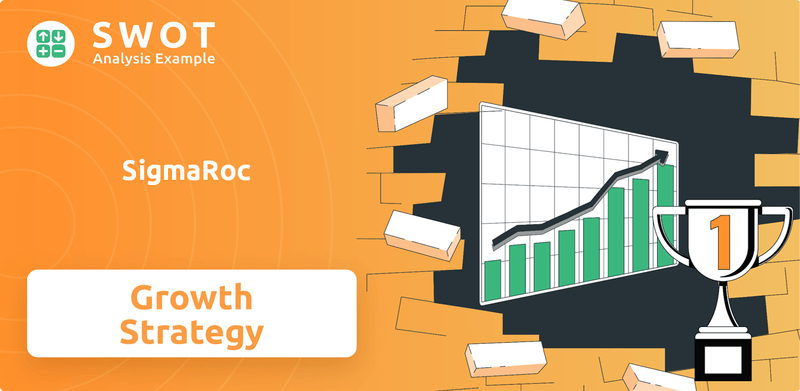
This analysis will explore SigmaRoc's strategic acquisitions, market position, and financial performance to assess its investment potential. We'll examine the company's expansion plans in Europe, including its cement and aggregates market share, and evaluate the impact of infrastructure spending. Furthermore, we will delve into SigmaRoc's long-term growth outlook, considering both the challenges and opportunities it faces in the competitive landscape, along with its sustainability initiatives and ESG performance.
How Is SigmaRoc Expanding Its Reach?
The expansion initiatives of the company are primarily centered on strategic acquisitions and organic growth, particularly within the lime and limestone sectors. The company's growth strategy involves a blend of acquiring existing assets and expanding its current operations. This approach is designed to strengthen its market position and capitalize on the rising demand for essential minerals in the construction and industrial sectors.
A significant move in 2024 was the transformational acquisition of lime and limestone assets from CRH plc. This £1 billion acquisition, completed in stages across several European countries, doubled the company's size and broadened its market presence. The company's focus on lime and limestone is strategic, aligning with the growing emphasis on sustainable practices within the industry. The company's strategic acquisitions 2024 are a key element of its expansion strategy.
Additionally, the company is actively managing its portfolio by divesting non-core assets. For example, the sale of ready-mix concrete plants in Belgium and France, with the French plants expected to be completed in 2025, allows the company to concentrate on its core lime and limestone operations. This strategic realignment supports the company's long-term growth outlook.
The company's most significant acquisition was the £1 billion purchase of lime and limestone assets from CRH plc in 2024. This involved assets across Germany, Czechia, Ireland, the UK, and Poland. This acquisition doubled the company's size, demonstrating a commitment to growth through strategic investments.
Construction has begun on a new aggregates and sand processing plant in Belgium. A new asphalt plant in South Wales has been commissioned. These projects highlight the company's commitment to expanding its operational capacity. The company plans to increase its annual revenue by 15% by 2025.
The company is divesting non-core assets to focus on its core lime and limestone operations. The sale of ready-mix concrete plants in Belgium and France is a key part of this strategy. The French plants are expected to be completed in 2025, allowing for a streamlined focus on core business segments.
The company's synergy program is progressing well, with £8 million delivered in 2024. The goal is to achieve a minimum of £33 million by 2027. These initiatives are driven by restructuring and cost-saving measures across various European regions, enhancing operational efficiency.
The company aims to increase its annual revenue by 15% by 2025, demonstrating ambitious growth targets. The company has set a 2030 target of 3-5% organic revenue growth per annum. These goals reflect the company's confidence in its expansion strategy and its ability to capitalize on market opportunities.
- The company's financial performance is supported by strategic acquisitions and organic growth initiatives.
- The company's geographical diversification strategy is enhanced through acquisitions and strategic investments.
- The company's expansion plans in Europe are focused on the lime and limestone sectors.
- The company's growth strategy is designed to capitalize on the demand for essential minerals.
For more insights into the company's background and initial strategies, you might find the Brief History of SigmaRoc article helpful.
SigmaRoc SWOT Analysis
- Complete SWOT Breakdown
- Fully Customizable
- Editable in Excel & Word
- Professional Formatting
- Investor-Ready Format
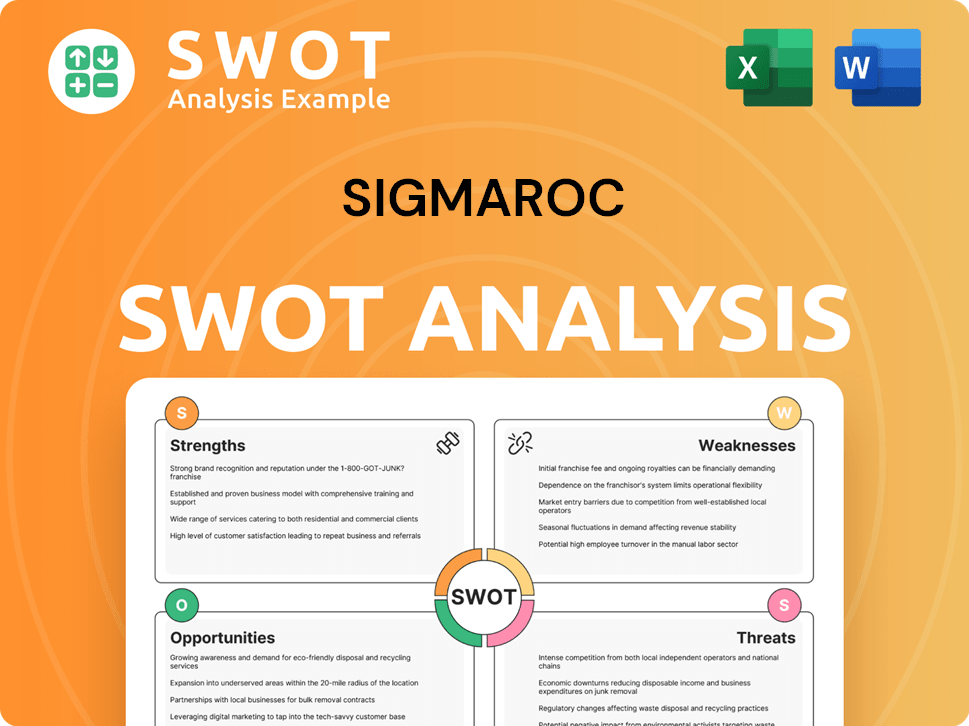
How Does SigmaRoc Invest in Innovation?
The company's growth strategy is heavily reliant on innovation and technology. This approach is crucial for maintaining a competitive edge in the construction materials market. The focus is on sustainable practices and operational efficiency to drive long-term value.
The company invests significantly in research and development, with an annual budget dedicated to innovative product solutions. This commitment to innovation is a key driver of its future prospects. The company's strategic initiatives are designed to enhance product offerings and optimize processes.
The company's commitment to sustainability is evident in its eco-friendly initiatives. The company is focused on reducing its environmental footprint and improving operational efficiency. These efforts are integral to its growth objectives.
The company allocates approximately £3 million annually to research and development. This investment supports the creation of innovative product solutions and helps the company maintain its market position. The increased investment in R&D is a core pillar of the company's strategy.
In 2024, the company launched a new line of eco-friendly concrete. This product reduces carbon emissions by 30% compared to traditional options. This demonstrates a commitment to green construction materials.
The company plans to invest £5 million annually in R&D to enhance product offerings and optimize processes. This investment anticipates new materials that meet evolving industry standards. This shows a strong focus on innovation.
The company aims for a 50% reduction in waste sent to landfills by 2025. It also targets an 85% recycling rate across production processes. These goals highlight the company's commitment to environmental responsibility.
Energy-efficient practices have reduced overall energy consumption by 15%. The company also aims for a 46% reduction in greenhouse gas emissions intensity from its 2021 baseline. This shows a commitment to reducing its carbon footprint.
The company utilizes 71% fossil-free electricity across the Group. This further reduces the environmental impact of its operations. This is a key step towards a more sustainable future.
The company's strategic focus on innovation and technology, combined with its sustainability initiatives, positions it well for future growth. These efforts are supported by digital transformation and automation. For more insights into the company's ownership structure and financial performance, you can read the article on Owners & Shareholders of SigmaRoc.
The company's strategy involves several key initiatives to drive growth and improve operational efficiency. These initiatives are designed to enhance product quality, reduce environmental impact, and improve operational efficiency. The company's focus on innovation and technology is a key driver of its future prospects.
- Investing in R&D to develop new, eco-friendly products.
- Implementing energy-efficient practices to reduce consumption.
- Utilizing digital transformation and automation to optimize processes.
- Focusing on sustainability initiatives to reduce waste and emissions.
- Targeting a high recycling rate across all production processes.
SigmaRoc PESTLE Analysis
- Covers All 6 PESTLE Categories
- No Research Needed – Save Hours of Work
- Built by Experts, Trusted by Consultants
- Instant Download, Ready to Use
- 100% Editable, Fully Customizable
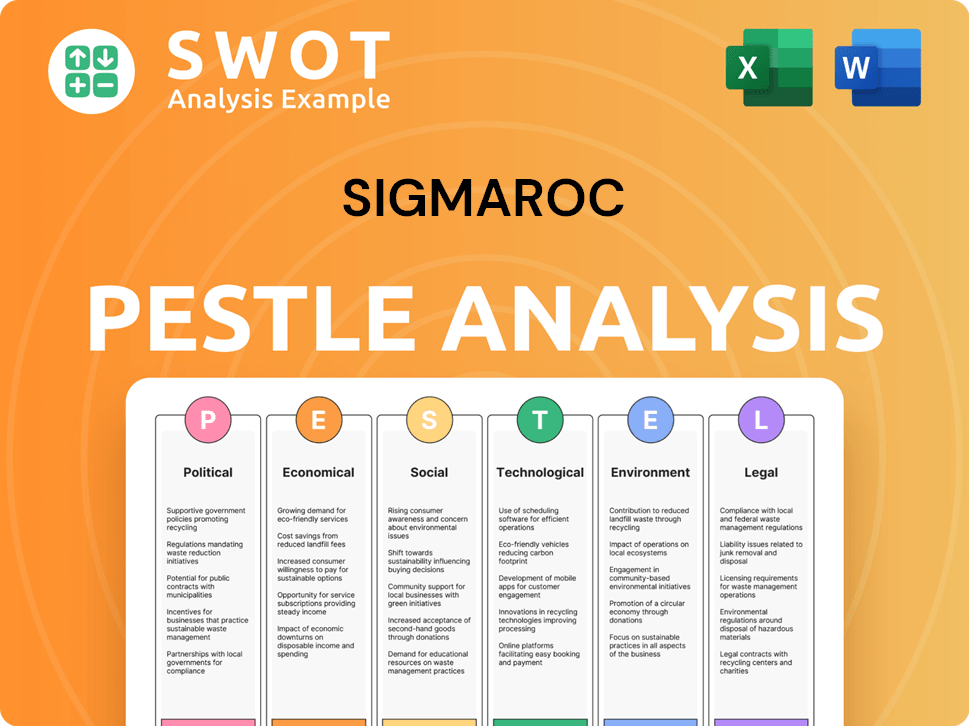
What Is SigmaRoc’s Growth Forecast?
The financial performance of SigmaRoc in 2024 reflects a strong growth trajectory, significantly influenced by strategic acquisitions. The company's revenue and profitability saw substantial increases, demonstrating effective integration and operational improvements. This performance sets a positive foundation for future growth and expansion, as highlighted in the company's strategic outlook.
SigmaRoc's strategic acquisitions, particularly in the lime sector, were pivotal in driving revenue growth. The company's focus on operational efficiency and synergy realization has led to improved margins and profitability. The positive financial results underscore the success of SigmaRoc's growth strategy and its ability to capitalize on market opportunities.
The company's financial outlook for 2025 remains positive, supported by a robust performance in the first quarter. Despite macroeconomic uncertainties, SigmaRoc is positioned to continue its growth, driven by its strategic initiatives and operational excellence. For a detailed look at the company's target market, you can explore the Target Market of SigmaRoc.
Total revenue increased by 72% year-on-year to £997.6 million in 2024, up from £580.3 million in 2023. This significant increase was primarily due to contributions from the lime acquisitions, demonstrating the success of SigmaRoc's strategic acquisitions.
Underlying EBITDA for 2024 increased by 92% to £224.6 million, compared to £116.7 million in 2023. The underlying EBITDA margin improved by 240 basis points to 22.5%, highlighting improved operational efficiency and profitability.
Underlying profit before taxation for 2024 was £119.7 million, a substantial increase from £71.2 million in 2023. This increase reflects the company's strong financial performance and effective cost management.
For Q1 2025, SigmaRoc reported an 18% year-on-year increase in group revenue to £252 million. Underlying EBITDA climbed by 30% to £49 million, with the EBITDA margin improving to approximately 19% from 18%.
The synergy program is on track to deliver at least €40 million in savings. The company targets a minimum of £33 million in savings by 2027, contributing to improved profitability and financial performance.
SigmaRoc has set ambitious financial targets for 2030, including organic revenue growth of 3-5% per annum. The company aims for an EBITDA margin of over 24% and a cash conversion rate of over 50%.
The company aims for a leverage ratio between 1.5 and 2.0 times. SigmaRoc targets a return on invested capital (ROIC) of over 15%, indicating efficient capital allocation and strong investment potential.
SigmaRoc's strategic acquisitions and operational improvements have strengthened its market position. The company's focus on cement and aggregates, along with expansion plans, supports its long-term growth outlook.
The company's strong financial performance and positive outlook suggest significant investment potential. SigmaRoc's strategic acquisitions and focus on operational excellence make it an attractive investment.
The company's expansion plans and strategic acquisitions contribute to geographical diversification. This strategy helps to mitigate risks and capitalize on opportunities in various markets.
SigmaRoc Business Model Canvas
- Complete 9-Block Business Model Canvas
- Effortlessly Communicate Your Business Strategy
- Investor-Ready BMC Format
- 100% Editable and Customizable
- Clear and Structured Layout
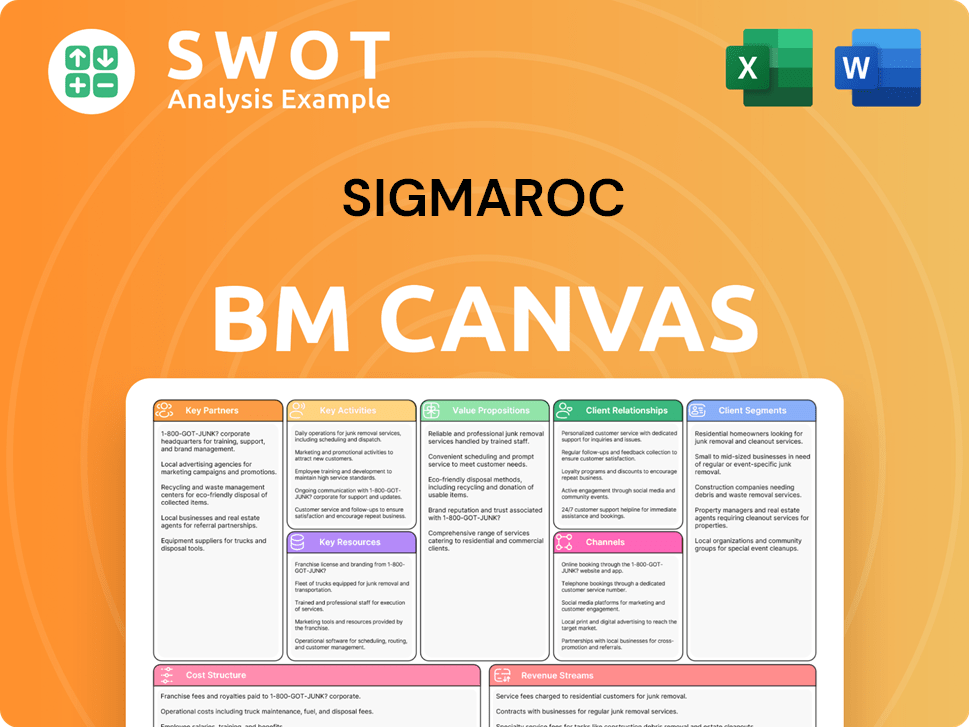
What Risks Could Slow SigmaRoc’s Growth?
Several strategic and operational risks could impact the growth ambitions of the company. These risks include market competition, regulatory changes, and supply chain vulnerabilities. The company is actively managing these risks through strategic diversification and operational efficiencies.
The construction materials sector is highly competitive, presenting a constant challenge. Regulatory changes, particularly those related to environmental standards and carbon emissions, could affect the company's costs and product development. Supply chain issues, influenced by global events, also pose a significant risk.
The company acknowledges the volatile political and economic environment, including the softness in residential construction. Despite these challenges, the company's diversified business model and broad market exposure are key to navigating these risks. The company is focused on lime and limestone as critical minerals for sustainable industries.
The construction materials sector is highly fragmented, with numerous competitors. This intense competition can affect pricing and market share. The company's ability to differentiate itself and maintain a competitive edge is crucial.
Changes in environmental regulations, especially concerning carbon emissions, could increase operational costs. The company's proactive sustainability initiatives are essential, but compliance remains a key area of focus. Adapting to evolving standards is critical.
Global events and geopolitical factors can disrupt the supply of raw materials and logistics. These disruptions can lead to increased costs and delays. The company must maintain a resilient supply chain.
The company operates in a volatile economic and political environment, which can affect its financial performance. Economic downturns and political instability can reduce demand and increase uncertainty. Careful monitoring and risk management are essential.
The residential construction market, and some areas within the environmental and steel markets, may experience continued softness. This could impact sales volumes and profitability. Diversification helps mitigate these effects.
Geopolitical events can significantly impact the company's operations, particularly those related to supply chains and market access. These factors can introduce uncertainty and require proactive risk management strategies. Understanding the Competitors Landscape of SigmaRoc is crucial.
The company's strategic diversification, including its focus on lime and limestone, is a key risk mitigation strategy. The synergy program, aimed at significant cost savings, also improves operational efficiencies. While the company has seen a positive start to 2025, it remains vigilant of the wider macroeconomic and geopolitical environment. The company's management team actively assesses and prepares for these risks.
Diversifying its product offerings and geographical presence helps the company mitigate risks. Expanding into new markets and product lines can reduce dependence on any single area. This strategy enhances the company's resilience.
The synergy program and other initiatives to improve operational efficiencies are crucial. These efforts help reduce costs and enhance profitability. Streamlining operations improves the company's competitive position.
The company's commitment to sustainability, including its focus on lime and limestone, is important. This focus aligns with evolving regulatory requirements and consumer preferences. Sustainability can also create new market opportunities.
The company's management team actively monitors and manages risks. This includes assessing the impact of macroeconomic and geopolitical factors. Regular risk assessments enable the company to respond effectively to challenges.
SigmaRoc Porter's Five Forces Analysis
- Covers All 5 Competitive Forces in Detail
- Structured for Consultants, Students, and Founders
- 100% Editable in Microsoft Word & Excel
- Instant Digital Download – Use Immediately
- Compatible with Mac & PC – Fully Unlocked
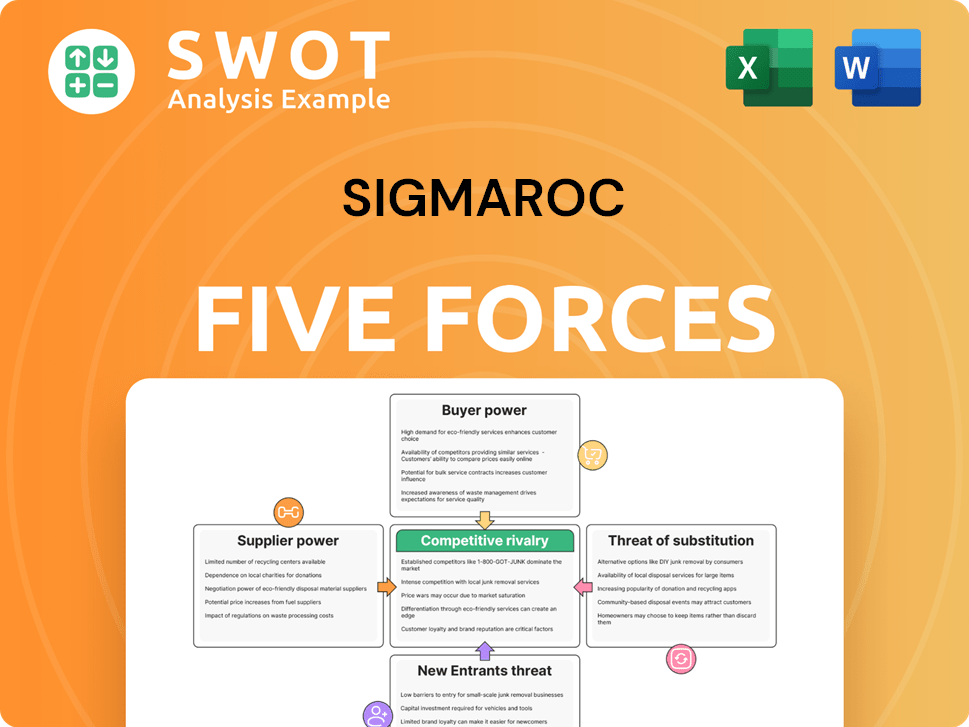
Related Blogs
- What are Mission Vision & Core Values of SigmaRoc Company?
- What is Competitive Landscape of SigmaRoc Company?
- How Does SigmaRoc Company Work?
- What is Sales and Marketing Strategy of SigmaRoc Company?
- What is Brief History of SigmaRoc Company?
- Who Owns SigmaRoc Company?
- What is Customer Demographics and Target Market of SigmaRoc Company?
Disclaimer
All information, articles, and product details provided on this website are for general informational and educational purposes only. We do not claim any ownership over, nor do we intend to infringe upon, any trademarks, copyrights, logos, brand names, or other intellectual property mentioned or depicted on this site. Such intellectual property remains the property of its respective owners, and any references here are made solely for identification or informational purposes, without implying any affiliation, endorsement, or partnership.
We make no representations or warranties, express or implied, regarding the accuracy, completeness, or suitability of any content or products presented. Nothing on this website should be construed as legal, tax, investment, financial, medical, or other professional advice. In addition, no part of this site—including articles or product references—constitutes a solicitation, recommendation, endorsement, advertisement, or offer to buy or sell any securities, franchises, or other financial instruments, particularly in jurisdictions where such activity would be unlawful.
All content is of a general nature and may not address the specific circumstances of any individual or entity. It is not a substitute for professional advice or services. Any actions you take based on the information provided here are strictly at your own risk. You accept full responsibility for any decisions or outcomes arising from your use of this website and agree to release us from any liability in connection with your use of, or reliance upon, the content or products found herein.